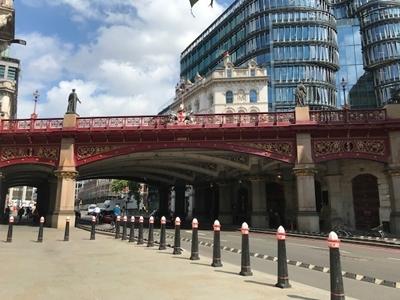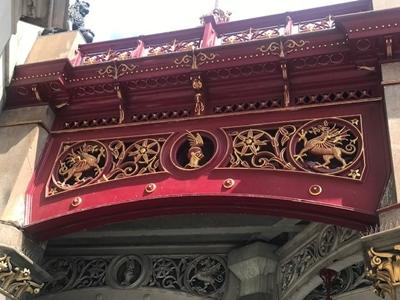
By the 1850s access to the City of London was becoming congested and difficult. The main problem was the steep-sided valley of the River Fleet – a small tributary of the Thames that rises on Hampstead Heath and enters the Thames near Blackfrair’s Bridge. Today most of the Fleet flows underground having had roads built over it. But in the 1850s most of it was open.
Pedestrians and horse-drawn carts had to creep down steep streets to the Fleet, cross by way of two narrow bridges and then clamber up the steep slope on the other side into the City. The City decided to solve the problems with a massive construction project of which the Viaduct was the centrepiece. The viaduct was built to span the valley of the old River Fleet, which was covered in and channelled underground with Farringdon Street built on top of it. There was much demolition and litigation as well as new construction. The plan included not only Farringdon Street over the Fleet, but also Holborn Circus, Charterhouse Street and St Andrew Street.
With its "iron girder skew bridge, borne on granite pillars," the new arrangement was seen as "the City's showpiece contribution to the Victorian modernisation of the capital". The name of the engineer, given in the inscription on one of the base pillars, was William Haywood (in some sources spelt Heywood), who served ably for 49 years as the Chief Engineer to the City Commissioners of Sewers. Note that after the River Fleet was covered over, it was used as a sewer, a purpose it still serves today.
The bridge was built to be a showpiece with top quality ornate ironwork and beautifully carved granite piers. The roadway above was flanked by magnificent bronze sculputres. There are four winged lions at the ends of the viaduct, each with its left paw resting on a small globe. On the north side are two female figures, representing Science and Fine Arts. On the south side are two other female statues representing Commerce and Agriculture. Commerce wears a mural crown which suggests the status and fortune of the city. She holds coins and gold in one hand, while the other hand is stretched out in welcome. At her feet are the keys of the city and a parchment offering the freedom of the city. Agriculture's crown is fashioned of olive leaves, and her robe is fringed with oak leaves. Beside her grows corn mixed with poppies.
Queen Victoria herself came to open the Viaduct in 1869. A contemporary account reads:
“Two colossal plaster statues, one bearing the palm of Victory, the other the olive-branch of Peace, were set up at the entrance, and numerous banners helped the general effect. Along the level approach to the Viaduct, which was from end to end strewn with yellow sand, seats were placed under cover, and in well-arranged blocks, for the guests of the Corporation. Above these streamed in the fresh breeze bannerets of the dagger and St. George's Cross on a white ground, from days immemorial the arms of the City of London; and the masts to which they were attached were painted and gilt. The pavilion, which had seats for 600 spectators, was constructed of red and white striped canvas at the sides, but of goldcoloured hangings, with devices in colour at the end, and with curtains of maroon to keep out the draughts”.


